Briefing of mass load caused site displacements
On seasonal time scales, surface mass load caused seasonal site displacements are the main feature
of the space geodesy observed site position time series (see Dong et al. 2002). In many applications,
space geodesy (like GPS) observed seasonal site displacements become important signals to
compare with mass loading predicted seasonal site displacements due to various geophysical
processes. In this case, mass loading caused site displacements should be calculated explicitly from
independent geophysical data.
QOCA utility mload provides such a function to calculate the site displacements from
atmospheric pressure, pole tide, non-tidal ocean mass, snow and soil moisture.
The mload adopts the Green's function approach to calculate the mass load caused site
displacements. All the Green's functions are defined in the CE frame (center of mass of the solid
Earth). The space geodesy solutions are usually aligned to the ITRF frame. The origin of the ITRF
frame is officially defined as the CM frame (center of mass of the whole Earth including atmosphere
and oceans). If that is true, the mass load predicted seasonal site displacements cannot be compared
directly with the space geodesy observed seasonal site dislacements due to the inconsistency of the
reference frames (CE vs. CM). However, on the seasonal time scales, the realized nature of the ITRF
origin is not the CM, but the CF (center of the surface figure of the Earth) (see details in Dong et al.
2003). Since the difference between CE and CF is very small, so that in practice we can compare
the solutions between the mass load predicted and the space geodesy observed site displacements.
To run the mload, just typing:
mload mload.drv
All the commands are stored in the mload.drv file. The mload.drv file has the same structure
and convention as other QOCA driver file. If you are not familiar with the driver file, please look at
the basic class web page first. The command lines of the mload.drv file are as followings:
infile: (input data file list)
The format of the list file is the same as QOCA data list file.
in_style: (input data file style)
The mload utility accepts multiple data file types.
= 1: NCEP atmosphere surface pressure, 6 hour sampling, 2.5 X 2.5 grid, netcdf
format
= 2: NCEP atmosphere surface pressure, daily sampling, 2.5 X 2.5 grid, netcdf format
= 3: TOPEX/JASON altimeter data, 10-day sampling, 1.0 X 1.0 grid, JPL format
= 4: equilibrium pole tide, input file is pmu file
= 5: self-consistent pole tide, input file is pmu file, 0.5 X 0.5 grid
= 6: NCEP reanalysis II soil moisture, daily sampling, 1.875 X 1.875 grid, netcdf
format
= 7: NCEP reanalysis II snow depth, daily sampling, 1.875 X 1.875 grid, netcdf
format
= 8: TOPEX/JASON altimeter data, 10-day sampling, 1.0 X 1.0 grid, CSR format
= 9: ECCO ocean model, 12-hour sampling, 1.0 X 0.3-1.0 grid, netcdf format
= 10: GLDAS monthly atmospheric surface pressure 1.0 X 1.0, GRIB format
transfered (not finished)
= 11: GLDAS monthly snow depth 1.0 X 1.0, GRIB format transfered
= 12: GLDAS monthly soil moisture 1.0 X 1.0, GRIB format transfered
�
= 13: GLDAS monthly canopy water storage 1.0 X 1.0, GRIB format transfered
= 14: glacier file (special format)
= 15: net mass (mload output, re-arranged) for sea level
We will give more details about the data file structure.
log_file: (output log file name)
This is actuary the running log file, not the output solution file.
sitlist file: (list of site name, longitude and latitude)
reffil file: (reference file name)
For atmosphere, non-tidal ocean, soil moisture and snow loading, we need
remove a constant bias. In this case, we take multi year average of the
data file on each grid, the resultant file is the reference file.
For self-consistent pole tide (in_style = 5), the reference file is the
map file from Desai (2002).
WE put our reference files in the QOCA templates directory.
grid_pres_ave.80_97 for atmosphere, ref_1997_2007.soilw for soil moisture,
ref_1997_2007.snow for snow, and ref_1997_2007.ocean for ECCO ocean.
ocean function file: (land-sea mask file)
The land-sea mask file should have the same grid as the input data file.
Thus, for different input data, we shuld prepare different land-sea mask files.
For ECCO model, the land-mask is un-necessary because the ECCO model has the
land-mask information build in its model.
In the QOCA templates sub-directory, ocean.fcn_new mask file for atmosphere,
land_sea.mask file for soil moisture and snow.
ib_option : (option to use IB or NIB model)
= 0: NIB model
= 1: IB model
average interval: (unit day)
If the average interval is smaller than the data sampling interval, there
will be no average. Otherwise, the program will output the averaged result.
sub_latitude: (minimum latitude, maximum latitude)
sub_longitude: (minimum longitude, maximum longitude)
Sometimes, we are interested in the contribution from a sub-region mass
loading. In this case, only the mass loading within the specified
latitude and longitude region is used to calculate the site position
variation.
start epoch: (year, month, day, hour, minute: all are integers)
final epoch: (year, month, day, hour, minute: all are integers)
Sometimes, we are interested in the mass loading effects with a time
interval. In this case, the specified start and final epoch set up
the constraints.
out_type: site or harmonics. Most common used is "site".
out_format: load or map. Most common used is "load". In the load format output file,
the output columns are: year, month, day, hour, JD, vertical, north, east, gravity.
out_path: give the sub-directory name. All output file will be stored in this
�
sub-directory.
Atmospheric mass loading calculation
In mload, we use NCEP reanalysis atmospheric surface pressure data to calculate mass loading
caused site displacemnts. NCEP uses NetCDF format to archive their reanalysis solutions. Our
mload program enbeds a simplified tool to read the NetCDF format file. More general reading tool
requires the installations of both netcdf and udunit libraries.
NetCDF (network Common Data Form) is an interface for array-oriented data access and a
library that provides an implementation of the interface. The netCDF library also defines a machine-
independent format for representing scientific data. Together, the interface, library, and format
support the creation, access, and sharing of scientific data.
In NetCDF file, the data is divided into several parts. The reading tool restores the final data by
the formula:
final_data = read_data * scale + offset
The unit of NCEP reanalysis atmosphere surface pressure data is Pascal. Since we are interested
in the variations of the surface pressure caused site displacements, not the absolute displacements,
we subtract a reference value at each grid. In mload, such a reference values are obtaines in a
reference file. For atmospheric mass loading, the reference file is derived by multi-year average of
the surface pressure data on each grid.
The site displacements from the global surface pressure data are calculated using Green's
function approach. In mload, we use Farrel's Green functions. For the ocean's response to surface
pressure variations, the "Inverted Barometer" (IB) model is generally adopted. Such an IB
assumption is probably valid for low frequency variations (period more than one day). For high-
frequency variations, the ocean's fluid dynamics might be taken into account. In mload.drv file, the
option of choosing IB or NIB model is realized by the "ib_option" command line.
The mload program recognizes two types of NCEP reanalysis surface pressure data files: 6-hour
sampling and 1-day average files. Sometimes, we only need averaged results, for example the daily-
mean site displacements rather than 6-hour site displacements. The mload program has an option
"average interval" to realize the average. If you specify 1.0, mload will output daily mean site
displacements. If you specify 5.0, mload will output 5-day mean site displacements.
The mload program also provides the option to specify region (box region bounded by latitude
and longitude) and time interval (start and end epochs). These options bring flexibility to perform
more detailed research.
The "outfile" in mload.drv is not the output solution file. It actuary is a log file, which records
some running and data i/o information. The output solution files are site_name.aload. Here the
site_name is from the "sitlist" file. If there are multiple sites in the "sitlist" file, the mload will output
multiple output solution files. Here the suffix "aload" of the output file name is fixed for mload,
which represents the site displacements caused by atmosphere loading.
The output solution file has such records:
FAIR_GPS lon= 212.493358 colat= 25.021999
2000 1 1 0 2451544.50 -2.5407 -0.3077 -1.9582 -0.8366404E-06
2000 1 2 0 2451545.50 -2.8449 -0.3481 -1.4388 -0.9856214E-06
2000 1 3 0 2451546.50 -1.5950 -0.5006 -1.1025 -0.6798246E-06
The columns of the solution records are:
�
year month day hour JD vertical north east gravity
Where the unit of the site displacements is mm (positive in up, north, east directions).
Please click the selection button of the above window to see the various file formats. Since the
NCEP reanalysis surface presure data file uses the 2.5 X 2.5 grid, the ocean function file should use
the same 2.5 X 2.5 resolution land-sea mask file, where the value great than 0 means land, others
are ocean.
Non-tidal ocean mass loading
We use the TOPEX/Posaidon, JASON altimeter measurements as the input data. These data
directly measure the sea surface height. Since there are many contributors affect the sea surface
height, the relatively well-known (or can be easily modeled) contributions are modeled and removed
from the final result.
Soil moisture mass loading
Snow mass loading
GLDAS model
GLDAS (Global Land Data Assimilation System) is a modern land surface state and flux
assimilation system. It is based on the land surface models and integrates huge observation data to
generate the products. Currently it has 4 commonly used models: Mosaic, Noah, CLM (Community
Land Model) and VIC (Variable Infiltration Capacity) models. Its temporal resolution is 3-hourly.
Monthly products are generated through averaging the 3-hourly products. Currently, mload is
mainly focused on the NOAH (NCEP, Oregon State University, United States Air Force, and Office
of Hydrology) model, which has 1 x 1 and 0.25 x 0.25 spatial resolution solutions. Currently only 1
x 1 model is well tested.
Note the GLDAS model covers only latitude 60S to 90N region, so that the surface mass
redistribution in Antarctica must be calculated using other data sets. Since the observational
constrains in Greenland are poor, the GLDAS solutions in Greenland are not very reliable.
GLDAS files are in GRIB format and include all surface state solutions. To save the analysis
time, MLOAD accepts only reorganized text format. To generate the MLOAD recognized format
file, please use the following wgrib commands.
ftp agdisc.gsfc.nasa.gov (anonymous log in)
cd data/s4pa/GLDAS
cd GLDAS_NOAH10_M (for Noah model monthly 1.0 grid data)
To get atmospheric surface pressure data:
wgrib -s data/GLDAS_NOAH10_M.A199201.001.grb | egrep ":PSurf:" | wgrib -i \
data/GLDAS_NOAH10_M.A199201.001.grb -nh -text -append -o atmos/gldas_atmos.1992
To get canopy equivalent water height data:
wgrib -s data/GLDAS_NOAH10_M.A199201.001.grb | egrep ":Canopint:" | wgrib -i \
data/GLDAS_NOAH10_M.A199201.001.grb -nh -text -append -o canopy/gldas_canopy.1992
To get snow equivalent water height data:
wgrib -s data/GLDAS_NOAH10_M.A199201.001.grb | egrep ":SWE:" | wgrib -i \
data/GLDAS_NOAH10_M.A199201.001.grb -nh -text -append -o snow/gldas_snow.1992
To get soil moisture equivalent water height data:
wgrib -s data/GLDAS_NOAH10_M.A199201.001.grb | egrep ":SoilM:" | wgrib -i \
data/GLDAS_NOAH10_M.A199201.001.grb -nh -text -append -o soil/gldas_soil.1992
�
In mload driver file, when you specify the correct in_style, mload can analyzes these GLDAS
transferred files. Note for the soil moisture different models have different layer number. For
example, CLS model has 10 layers and Noah model has 4 layers. In this case, users should specify
the layer number to distinquish different models. For example, if user wants to process Noah model
soil moisture data file, the command is:
in_style : 12 4
The last number represents the layer number.
Currently mload implements the "exclude" option for GLDAS format (in_style 12, 13, 14). To
execise this option, the driver file should add this command line:
exclude region file : exclu.region
The format of the exclu.region is as followings:
2
0.0 359.0 -90.0 -60.0 # Antarctica
290.0 345.0 62.0 85.0 # Greenland + small part of Canada
---- NOT FINISHED YET ----
�
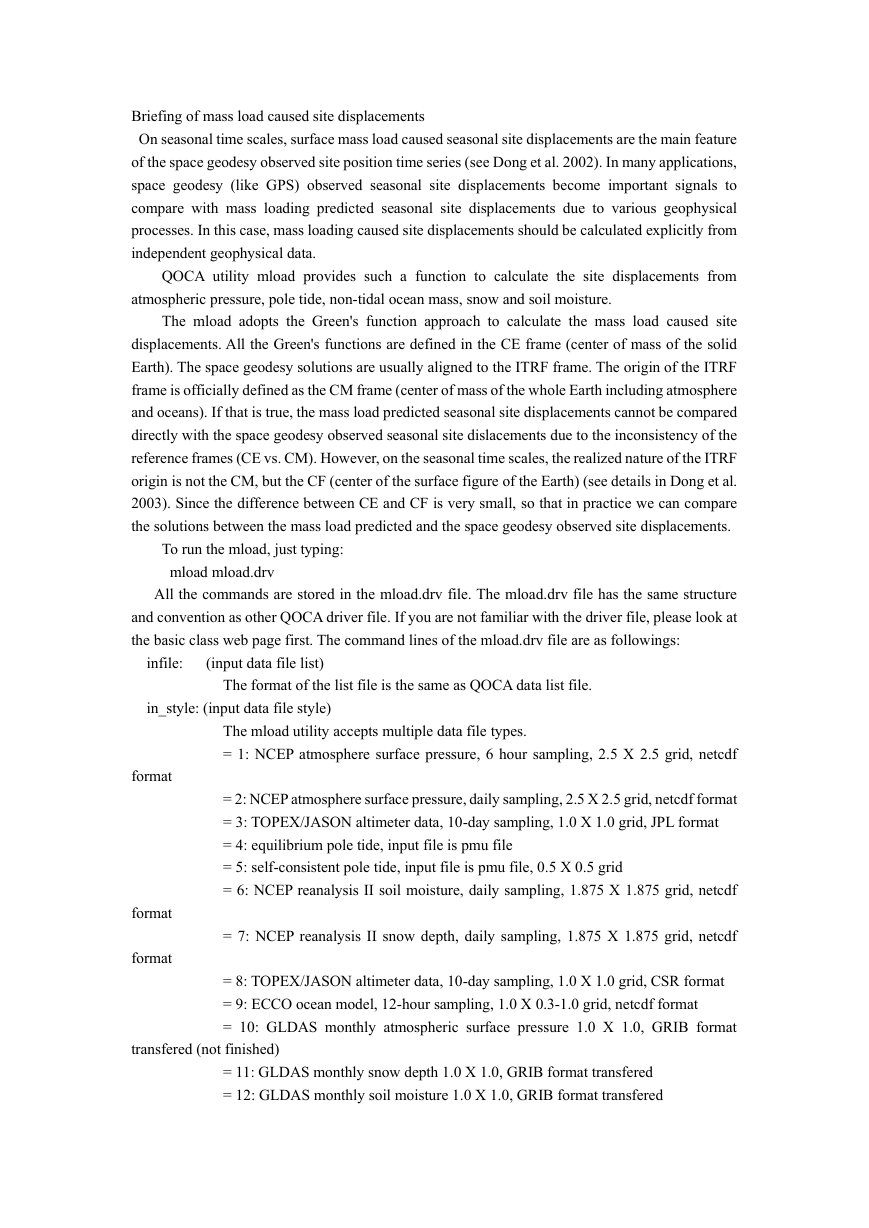
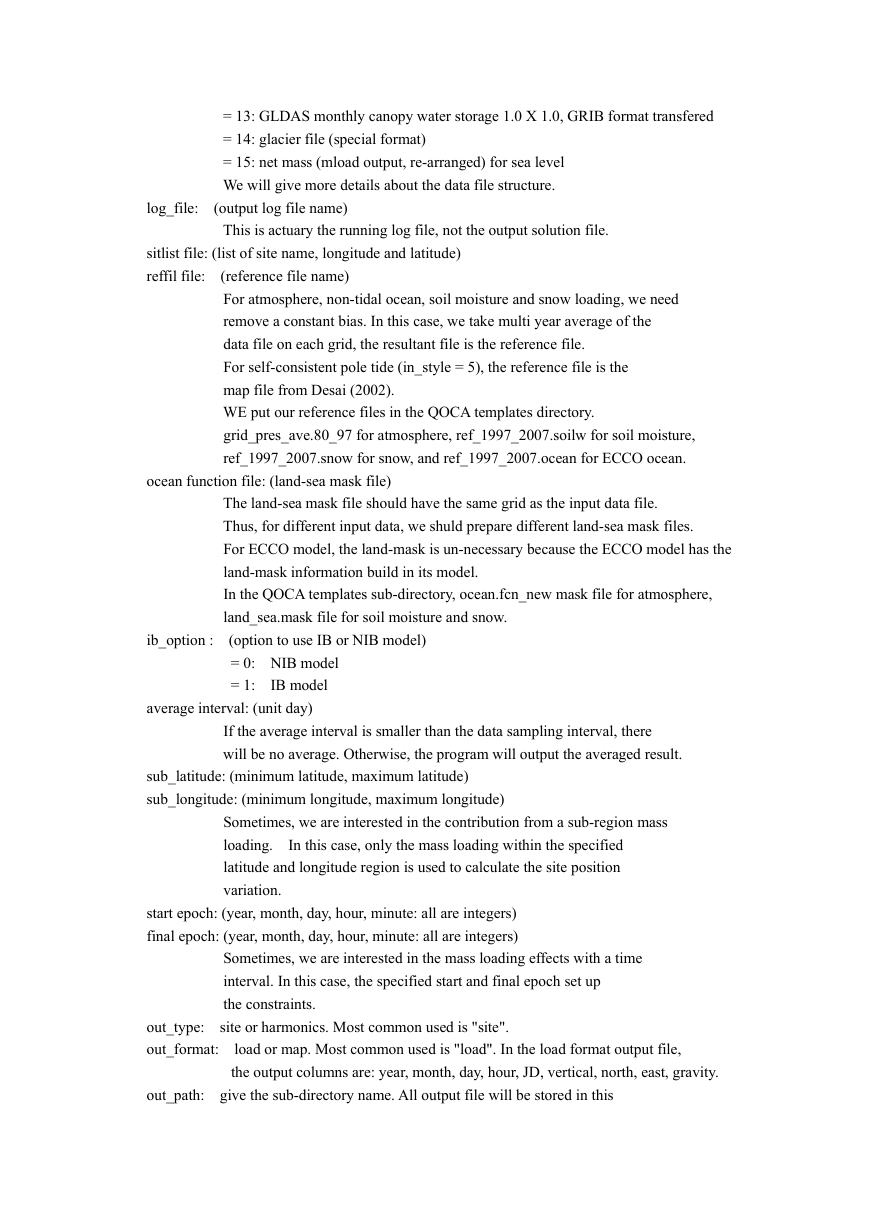
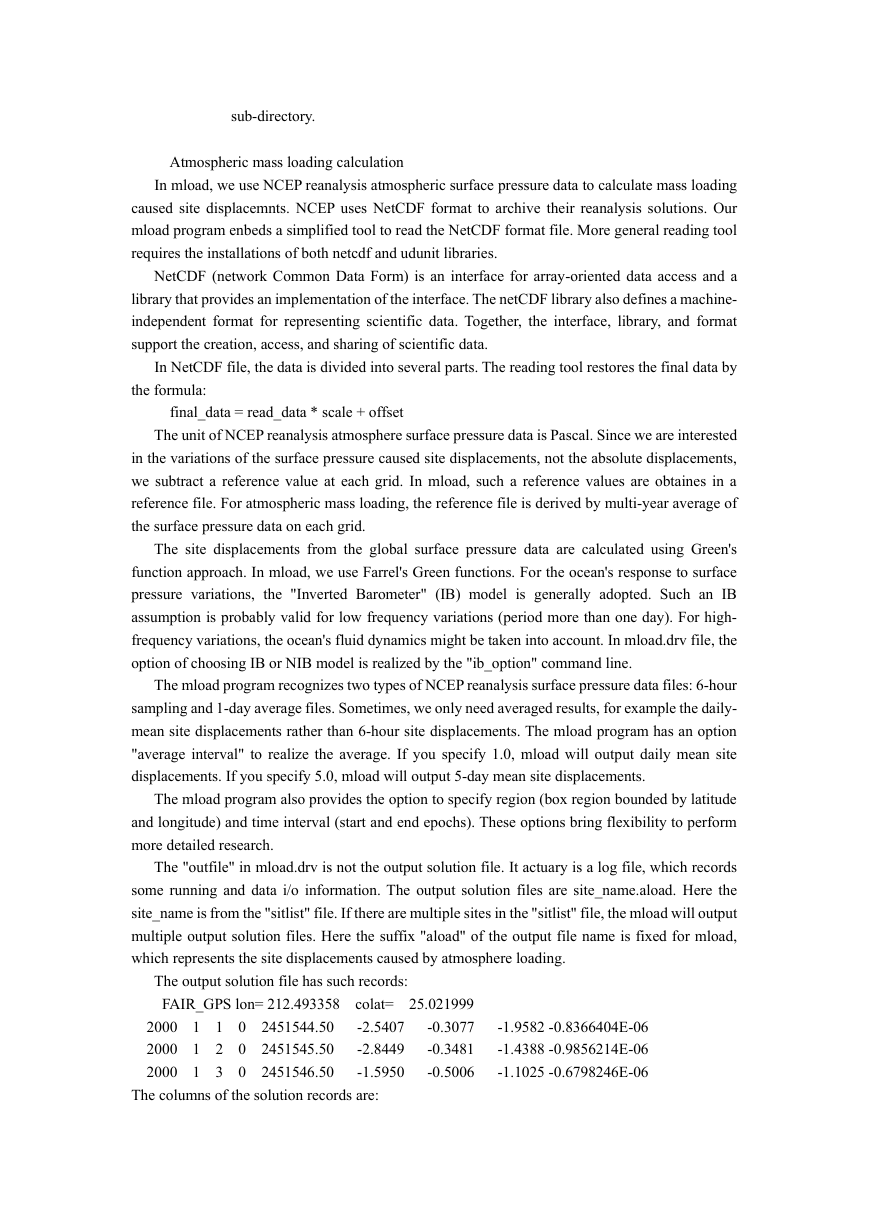
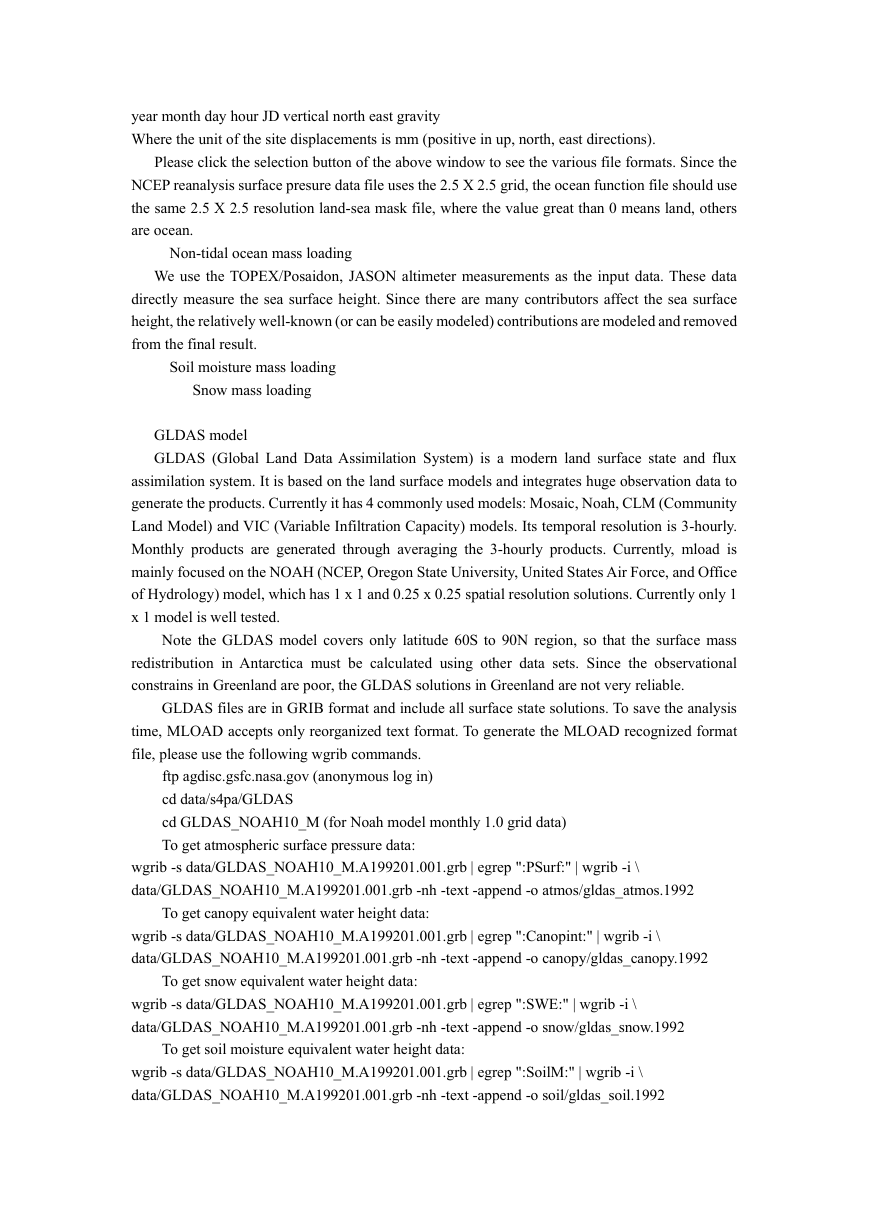
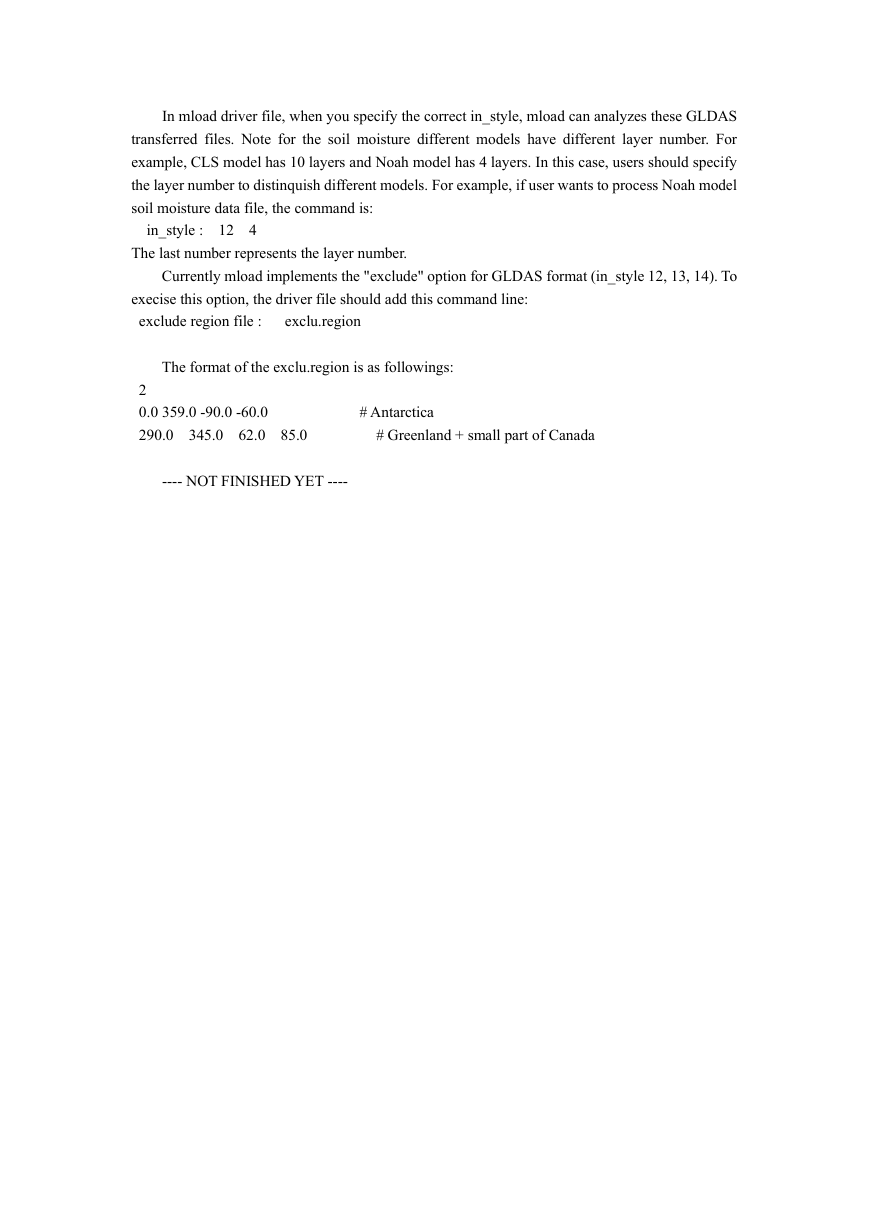





 2023年江西萍乡中考道德与法治真题及答案.doc
2023年江西萍乡中考道德与法治真题及答案.doc 2012年重庆南川中考生物真题及答案.doc
2012年重庆南川中考生物真题及答案.doc 2013年江西师范大学地理学综合及文艺理论基础考研真题.doc
2013年江西师范大学地理学综合及文艺理论基础考研真题.doc 2020年四川甘孜小升初语文真题及答案I卷.doc
2020年四川甘孜小升初语文真题及答案I卷.doc 2020年注册岩土工程师专业基础考试真题及答案.doc
2020年注册岩土工程师专业基础考试真题及答案.doc 2023-2024学年福建省厦门市九年级上学期数学月考试题及答案.doc
2023-2024学年福建省厦门市九年级上学期数学月考试题及答案.doc 2021-2022学年辽宁省沈阳市大东区九年级上学期语文期末试题及答案.doc
2021-2022学年辽宁省沈阳市大东区九年级上学期语文期末试题及答案.doc 2022-2023学年北京东城区初三第一学期物理期末试卷及答案.doc
2022-2023学年北京东城区初三第一学期物理期末试卷及答案.doc 2018上半年江西教师资格初中地理学科知识与教学能力真题及答案.doc
2018上半年江西教师资格初中地理学科知识与教学能力真题及答案.doc 2012年河北国家公务员申论考试真题及答案-省级.doc
2012年河北国家公务员申论考试真题及答案-省级.doc 2020-2021学年江苏省扬州市江都区邵樊片九年级上学期数学第一次质量检测试题及答案.doc
2020-2021学年江苏省扬州市江都区邵樊片九年级上学期数学第一次质量检测试题及答案.doc 2022下半年黑龙江教师资格证中学综合素质真题及答案.doc
2022下半年黑龙江教师资格证中学综合素质真题及答案.doc